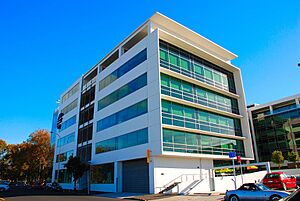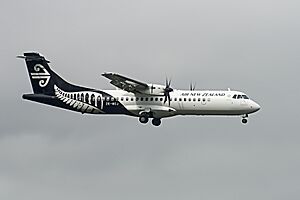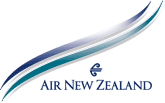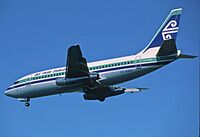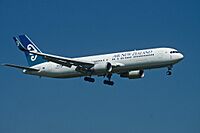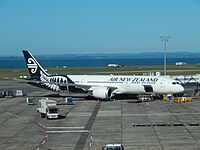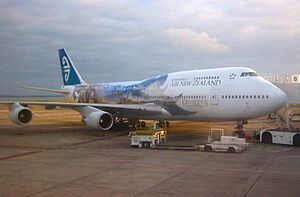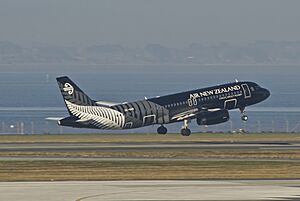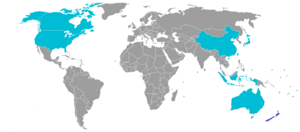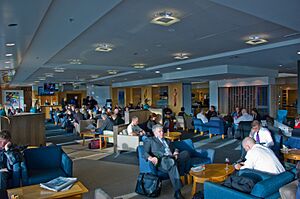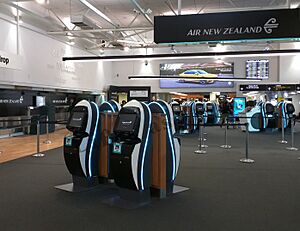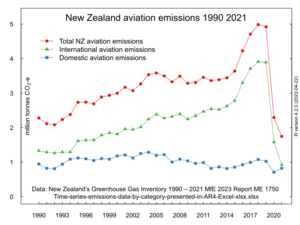Air New Zealand facts for kids

An Air New Zealand Boeing 787-9 Dreamliner
|
|
| Founded | 26 April 1940 (as Tasman Empire Airways Limited) |
|---|---|
| Commenced operations | 1 April 1965 (as Air New Zealand) |
| Hubs | |
| Frequent-flyer program | Airpoints |
| Alliance | Star Alliance |
| Fleet size | 111 |
| Destinations | 50 |
| Headquarters | Wynyard Quarter, Auckland, New Zealand |
| Key people |
|
| Revenue | |
| Operating income | |
| Profit | |
| Total assets | |
| Total equity | |
| Employees | 8,863 (2022) |
Air New Zealand Limited (Māori: Araraurangi Aotearoa) is the flag carrier of New Zealand. Based in Auckland, the airline operates scheduled passenger flights to 20 domestic and 30 international destinations in 18 countries, primarily within the Pacific Rim. The airline has been a member of the Star Alliance since 1999.
Air New Zealand succeeded Tasman Empire Airways Limited (TEAL) on 1 April 1965. The airline served only international routes until 1978, when the government merged it and the domestic New Zealand National Airways Corporation (NAC) into a single airline under the Air New Zealand name. Air New Zealand was privatised in 1989, but returned to majority government ownership in 2001 after nearing bankruptcy due to a failed tie-up with Australian carrier Ansett Australia. In the 2017 financial year to June, Air New Zealand carried 15.95 million passengers.
Air New Zealand's route network focuses on Australasia and the South Pacific, with long-haul flight services to eastern Asia and North America. It was the last airline to circumnavigate the world with flights to London Heathrow via Los Angeles and Hong Kong. The Hong Kong stopover was discontinued in March 2013 when Air New Zealand stopped Hong Kong–London flights in favour of a codeshare agreement with Cathay Pacific. Flights to London Heathrow by the airline stopped altogether in 2020 due to heavy competition and a lack of demand. The airline's main hub is Auckland Airport, located near Māngere in the southern part of the Auckland urban area. Air New Zealand is headquartered in a building called "The Hub", located 20 km (12 mi) from Auckland Airport, in Auckland's Wynyard Quarter.
Air New Zealand currently operates a mixed fleet consisting of the Airbus A320, Airbus A320neo family, Boeing 777, and Boeing 787 jet aircraft, as well as a regional fleet consisting of ATR 72 and Bombardier Q300 turboprop aircraft. Air New Zealand was awarded Airline of the Year in 2010 and 2012 by the Air Transport World Global Airline Awards. In 2014, Air New Zealand was ranked the safest airline in the world by JACDEC.
History
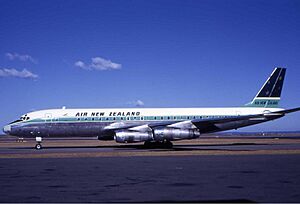
On 1 April 1965, Tasman Empire Airways Limited was rebranded as Air New Zealand.
With the increased range of the Douglas DC-8s the airline's first jet aircraft, Air New Zealand began transpacific services to the United States and Asia with Los Angeles and Honolulu added as destinations in 1965. The airline further acquired wide-body McDonnell Douglas DC-10 airliners in 1973. The DC-10s introduced the new koru-inspired logo for the airline, which remains to this day.
In 1978, the domestic airline National Airways Corporation (NAC) and its subsidiary Safe Air were merged into Air New Zealand to form a single national airline, further expanding the carrier's operations. As a result, NAC's Boeing 737 and Fokker F27 aircraft joined Air New Zealand's fleet alongside its DC-8 and DC-10 airliners. The merger also resulted in the airline having two IATA airline designators: TE from Air New Zealand and NZ from NAC. TE continued to be used for international flights and NZ for domestic flights until 1990, when international flights assumed the NZ code.
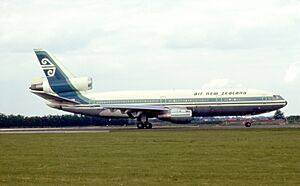
In 1981, Air New Zealand introduced its first Boeing 747 airliner, and a year later initiated service to London via Los Angeles. The five 747-200s owned by Air New Zealand were all named after ancestral Māori canoes. 1985 saw the introduction of Boeing 767-200ER airliners to fill the large size gap between the Boeing 737 and 747 (the DC-8 and DC-10 had been withdrawn by 1983). In 1989 the airline was privatised with a sale to a consortium headed by Brierley Investments. (with remaining stakes held by Qantas, Japan Airlines, American Airlines, and the New Zealand government). The New Zealand air transport market underwent deregulation in 1990, prompting Air New Zealand to acquire a 50% stake in Ansett Australia in 1995.
In March 1999, Air New Zealand became a member of the Star Alliance. From 1999 through 2000, Air New Zealand became embroiled in an ownership battle over Ansett with co-owner News Limited over a possible sale of the under-performing carrier to Singapore Airlines.
Merger with Ansett
In 2000, Air New Zealand announced that it had chosen instead to acquire the entirety of Ansett Transport Industries (increasing its 50% stake in the carrier to 100%) for A$680 million from News Corporation in an attempt to break into the Australian aviation market. Business commentators believe this to have been a critical mistake, as Ansett's fleet, staffing levels and infrastructure far outweighed that of Air New Zealand. Subsequently, both carriers' profitability came under question, and foreign offers to purchase the Air New Zealand Group were considered. In September 2001, plagued by costs it could not possibly afford, the Air New Zealand / Ansett Group neared collapse. A failed attempt at purchasing Virgin Blue was the final straw, and on 12 September, out of both time and cash, Air New Zealand placed Ansett Australia into voluntary administration, following which Ansett was forced to cease operations. Air New Zealand announced a NZ$1.425 billion operating loss. Air New Zealand was subsequently bailed out by the New Zealand Government, with Helen Clark's Labour Government taking an 82% stake in the company.
21st century
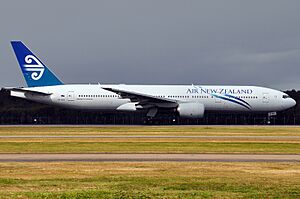
In October 2001, Air New Zealand was re-nationalised under a New Zealand government NZ$885 million rescue plan (with the government taking an 82% stake), and subsequently received new leadership. This act was the only thing that spared Air New Zealand from going into administration and likely grounding.
In 2002, Air New Zealand reconfigured its domestic operations under a low-cost airline business plan, and the New Zealand government refused a proposal from Qantas to purchase a one-fifth stake in the carrier. Air New Zealand returned to profitability in 2003, reporting a net profit of $NZ165.7 million for that year. The carrier saw increasing profits through 2004 and 2005. In 2004, the airline announced a relaunch of its long-haul product, featuring the introduction of new seats in its business, premium economy, and economy class cabins.
In 2003, Air New Zealand added the Airbus A320 to its fleet for use on short-haul international flights, and later domestic flights. In 2005, the airline received its first Boeing 777 (-200ER variant) aircraft and placed orders for the Boeing 787 Dreamliner in 2004. The airline was later announced as the launch customer for the −9 variant of the 787.
On 21 December 2010, the New Zealand government approved an alliance between Air New Zealand and Australian airline Virgin Blue (now named Virgin Australia), which allowed both airlines to expand their operations between Australia and New Zealand with codeshares for trans-Tasman and connecting domestic flights, and reciprocal access to frequent flyer programmes and airport lounges. Air New Zealand subsequently purchased a 26% shareholding in Virgin Australia Holdings to cement the relationship. By October 2016 Air New Zealand sold its remaining stake in Virgin Australia to investors and the Nasham Group. On 4 April 2018, Air New Zealand ended its partnership with Virgin Australia which went into effect from 28 October 2018.
In 2011, Air New Zealand introduced the Boeing 777-300ER to its fleet, as well as the Economy Skycouch, a set of three economy class seats that could be converted into a flat surface by raising the leg rests. After a four-year delay, Air New Zealand took delivery of its first Boeing 787-9 on 9 July 2014. The airline retired its final Boeing 747 in September 2014, its last Boeing 737 in September 2015, and its last Boeing 767 in March 2017, leaving it with a simplified fleet of Airbus A320 aircraft for short-haul operations and Boeing 777 and 787 aircraft for long-haul operations.
In November 2013, the New Zealand Government reduced its share in Air New Zealand from 73% to 53% as part of its controversial asset sales programme. It made $365 million from the deal.
In October 2019, the airline announced it would discontinue its Los Angeles to London route in October 2020 while launching a new non-stop route from Auckland to New York. The London route was prematurely cancelled in March 2020 due to the COVID-19 pandemic, while the launch of the New York route was rescheduled, with the first flight taking place on 17 September 2022.
Air New Zealand announced a major refurbishment of its existing cabins in June 2022, with new cabins including a new product named "The Skynest" to be introduced in the new Boeing 787-9 and 787-10 aircraft which are set to be delivered in 2024.
Corporate affairs and identity
Head office
The Air New Zealand head office, "The Hub", is a 15,600-square-metre (168,000 sq ft) office park located at the corner of Beaumont and Fanshawe streets in Wynyard Quarter, Auckland. The office includes two connected six-level buildings. The facility consists of a lot of glass to allow sunlight and therefore reduce electricity consumption. The building does not have cubicle walls. Sensors throughout the building can turn on lights if they detect human activity, and turn off lights if human activity is not detected for 15 minutes. The buildings cost $60 million New Zealand dollars to build and develop. From late September to early October 2006 the airline moved 1,000 employees from four buildings in the Auckland CBD and other buildings elsewhere.
The company previously had its head office in the Quay Tower in the CBD. In its history the airline had its head office in Airways House on Customs Street East.
The company also occupies premises at the Smales Farm Business Park in Takapuna on the North Shore, adjacent to the bus station and Northern motorway. It is home to the Contact Centre staff (additional to those at 'The Hub'), Tandem Travel and other services.
Subsidiaries
Operations subsidiaries
Air New Zealand Cargo is the only current subsidiary of Air New Zealand Limited.
Air New Zealand previously had wholly owned subsidiary regional airlines – Air Nelson, Mount Cook Airline and Eagle Airways – that served regional destinations throughout New Zealand. Together they made up Air New Zealand Link. On 26 August 2016, Eagle Airways ceased operations – Air Nelson and Mount Cook Airline followed in late 2019 and both were merged into its parent's operations.
- Air Nelson was based in Nelson, and operated Bombardier Q300s.
- Mount Cook Airline was based in Christchurch, and operated ATR 72–500 and ATR 72–600 turboprop aircraft.
Subsidiary company Zeal320 was introduced to help combat increasing labour costs. Zeal320 operated Air New Zealand's trans-Tasman fleet of Airbus A320-200 aircraft under the Air New Zealand brand. On 31 July 2006, flights were re-numbered to the NZ700-999 series for trans-Tasman services, and NZ1000 series for domestic services. All of Air New Zealand's A320-200s were registered to Zeal320 until 26 November 2008, when ownership of the fleet was transferred back to Air New Zealand. However, staff that worked the A320-200 fleet were still employed by the subsidiary. This was a source of contention within the airline group in which these employees were paid at a lower scale than their mainline counterparts. Continued industrial action by staff employed in the subsidiary during 2009 permanently delayed a proposed low-cost carrier airline as a successor to Freedom Air that would have also employed the Airbus A320 on domestic routes to counter Jetstar, which had begun operating domestically in New Zealand. In 2015 Zeal320 was removed from the New Zealand Companies Office.
Technical subsidiaries
The following are technical operations subsidiaries of Air New Zealand:
- Air New Zealand Engineering Services
- Christchurch Engine Centre (50%)
In June 2015, Air New Zealand confirmed the sale of its Safe Air engineering subsidiary to the Australian arm of Airbus.
Sponsorships
Air New Zealand was the title sponsor of the Air New Zealand Cup domestic rugby union club competition through the 2009 season. The airline remains a major sponsor of New Zealand rugby, including the New Zealand national rugby union team, known as the All Blacks. The airline also sponsors the Air New Zealand Wine Awards and World of Wearable Arts; and partners with New Zealand's Department of Conservation and Antarctica New Zealand.
Brand and livery
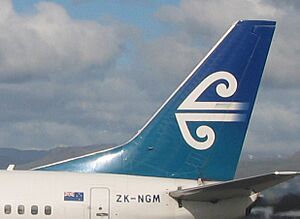
The Air New Zealand symbol is a Māori koru, a stylised representation of a silver fern frond unfolding. A redesigned logo was unveiled on 21 March 2006. The "Pacific Wave" fuselage stripes were removed from short-haul aircraft in 2009, simplifying the overall livery, and was in the process of also being removed from long haul aircraft before the logo was changed again.
On 27 March 2006, Air New Zealand revealed a new brand identity, involving a new Zambesi-designed uniform, new logo, new colour scheme and new look check-in counters and lounges. The new uniforms featured a colour palette mirroring the greenstone, teal, schist and slate hues of New Zealand's sea and sky. Uniform fabric was woven from merino wool and incorporated curves inspired by the airline's logo symbol, the koru. A greenstone colour replaces the blue Pacific Wave colour, inspired by the colour of the pounamu, the prized gemstone found in New Zealand. The Air New Zealand Koru was woven through all Air New Zealand's signage and products.
Later in 2009 staff were involved in testing fabrics and cuts of uniforms. "'It would be fair to say that the lessons from the development and introduction of the current uniform have been taken on board," said the airline's CEO after widespread public and staff criticism.
A rebranding was announced in July 2012. Dropping the teal and green colours that had represented the airline since its beginnings as Tasman Empire Airways (TEAL) in 1939, black was adopted as the brand colour in a joint effort between the airline, New Zealand design agency Designworks and renowned Kiwi typographer Kris Sowersby, who also introduced a new logo typeface. The tails of the aircraft and the typeface changed to black, while the rest of the fuselage remained white.
Then CEO Rob Fyfe said of the rebranding: "Black has resonated well with our customers and staff who identify with it as the colour of New Zealand and a natural choice for our national airline. It inspires pride, is part of our Kiwi identity and a symbol of Kiwi success on the world stage." The airline began using black as its corporate colour ahead of a sponsorship campaign with NZ's rugby union team, the All Blacks, in 2011.
Another new livery was announced on 12 June 2013. In conjunction with a NZ$20 million Memorandum of Understanding with the national tourism agency Tourism New Zealand for joint marketing, TNZ granted permission for Air New Zealand to use the "New Zealand Fern Mark", a standard fern logo used and managed by Tourism NZ and NZ Trade and Enterprise for international promotion, in its livery.
Two new liveries were unveiled. The first is predominantly white with a black strip running downwards on the rear fuselage from the tail, adorned with a koru logo in white, to disappear downwards just aft of the junction of the wings with the fuselage. The black and white fern mark adorns the fuselage. This livery is used on most of the fleet. A select number have an all black livery with the fern in silver, including the airline's first Boeing 787–9. Extensive consumer surveys by Air New Zealand revealed 78 percent people believed the Fern Mark fits with the airline's brand and represents New Zealand. The first aircraft to be painted in this livery was rolled out on 24 September 2013.
Special liveries
- In 1973, the first of the airline's McDonnell Douglas DC-10-30s arrived with 1974 British Commonwealth Games "NZ74" logo on both sides of the forward fuselage beneath the cabin windows.
- In 1984, pictures of the Buckingham Palace horse guards with 'London, Here We Come' were placed on the side of the hump of the airline's new Boeing 747-200Bs when Air New Zealand was allowed to fly the Los Angeles – London leg of the trans-Pacific route in its own name.
- A special livery featuring an image of the All Blacks front row of Carl Hoeft, Anton Oliver and Kees Meeuws and a black tail was used on the Boeing 747–400 aircraft used to transport the team to the 1999 Rugby World Cup. Two other aircraft wore the special All Blacks scheme: a Boeing 737-200QC and a Saab 340 of Air Nelson; both these aircraft retained their blue teal tail colours.
- In 1999, one Boeing 737–300 was painted in a 'New Millennium' livery depicting celebrations and the America's Cup regatta that was to be held in 2000.
- In 2002 and 2003 Air New Zealand marked its position as "the official airline to Middle Earth" by decorating three aircraft with The Lord of the Rings imagery, applied as giant decals. The decal material was described in airline publicity as being as thin as clingfilm and weighing more than 60 kilograms (130 lb). The imagery featured actors from the film trilogy The Lord of the Rings against backdrops of New Zealand locations used in the films.
- In 2008, one of the airline's Boeing 737-300s was painted into a lime green Air New Zealand 'Holidays' livery.
- During 2011 and 2012, two aircraft – an Airbus A320 and a Boeing 777-300ER – were painted in an All Blacks-inspired livery. The aircraft were completely black, with a silver fern motif covering the aft section of the fuselage. Some Air New Zealand Link aircraft were also decorated in the scheme: an ATR 72–600 operated by Mount Cook Airline; and two Beechcraft 1900Ds operated by now-defunct subsidiary Eagle Airways.
- In November 2012, Boeing 777-300ER ZK-OKP was repainted in the new "black-tail" livery and fitted with an 830 m2 (8,900 sq ft) decal promoting the premiere and release of the first film in The Hobbit trilogy. The decal took six days and 400-man-hours to install.
- In December 2013, ahead of the premiere of the second part of the Hobbit trilogy, The Desolation of Smaug, Air New Zealand applied two 54-metre long images of the dragon Smaug on the sides of a Boeing 777-300ER.
- In October 2023, Air New Zealand leased ex Cathay Pacific Boeing 777-367ER ZK-OKU (ex B-KPJ) on a three year lease from Air Lease Corporation. The airliner painted all white, features a black koru logo design, compared to the normal white.
Destinations
Air New Zealand serves 20 domestic destinations and 30 international destinations in eighteen countries and territories across Asia, North America and Oceania.
Air New Zealand previously operated four fifth freedom routes. The airline operated weekly flights from Rarotonga to Sydney and Los Angeles, in addition to flights connecting via Auckland. In 2012, after securing a contract from the Australian government – Air New Zealand launched twice-weekly services from Sydney and Brisbane to Norfolk Island on its A320 aircraft.
Air New Zealand has codeshare agreements with the following airlines:
On the 1st of May 2024, the Australian Competition and Consumer Commission voted in favour of supporting a proposed agreement of reintroducing a codeshare agreement between Air New Zealand and Virgin Australia. As of May 2024, there is no proposed timeline as to when this will occur, the two airlines currently have an interlining agreement.
Fleet
As of November 2023, Air New Zealand operates 108 aircraft. The jet fleet consists of 56 aircraft: 17 Airbus A320 and 17 Airbus A320/A321neo aircraft for short-haul flights, and eight Boeing 777-300ER and fourteen Boeing 787–9 Dreamliner jet aircraft for long-haul flights. The airline has six Airbus A321neo, 2 ATR 72s, and eight Boeing 787-9 aircraft on order.
The airline's turboprop fleet operates regional domestic services and consists of 52 aircraft: 29 ATR 72–600 aircraft and 23 De Havilland Canada Dash 8 Q300 aircraft.
Services
Cabins
Air New Zealand offers three classes on its wide-body Boeing 777 and 787 jets: business, premium economy, and economy. The airline operates a single-class economy cabin on its narrow-body Airbus A320/A321 jets and its turboprops.
Air New Zealand Lounge
The Air New Zealand Lounge is Air New Zealand's network of airline lounges around the world. Eligible Air New Zealand frequent flyer members, including Koru members and their guests, may access the lounges.
Airpoints
Airpoints is Air New Zealand's frequent-flyer programme. Members earn "Airpoints Dollars", which they can redeem at par with New Zealand dollars on any fare for flights ticketed and operated by Air New Zealand. Members can attain status tiers, with increasing privileges ranging from Silver to Gold, then Gold Elite, by accumulating their "Status Points", which are earned separately from Airpoints Dollars. Airpoints Gold and Airpoints Gold Elite have the same recognition as Star Alliance Gold status and benefits across the Star Alliance network. Airpoints Silver status is equivalent to Star Alliance Silver.
Airpoints members receive Status Points for almost every Air New Zealand flight, as well as for many other flights with its Star Alliance partners. Status Points enable members to reach a higher status faster.
Alternative propulsion
In a 2008 effort to develop an aviation biofuel, Air New Zealand and Boeing researched the jatropha plant to see if it was a viable green alternative to conventional fuel. A two-hour test flight, using a 50–50 mixture of the new biofuel with Jet A-1 feeding a Rolls-Royce RB211 engine of one of the airline's 747-400s, was completed on 30 December 2008. The engine was then removed to be scrutinised and studied to identify any differences between the jatropha blend and regular Jet A1. No effects to performances were found. The use of jatropha has been identified as a possible future fuel but large tracts of low quality land needed to grow the plant would have to be found without impeding other agricultural uses.
Awards
In 2020, Air New Zealand won an award "Best airline in Airline Excellence Awards 2020" carried out by AirlineRatings.com.
In 2023, Air New Zealand won AirlineRatings.com's Airline of the Year for 2023.
Baggage tracker policy
Although Air New Zealand and fellow Star Alliance member Lufthansa briefly banned baggage trackers in 2022, those bans and advisories were reversed in 2023.
See also
 In Spanish: Air New Zealand para niños
In Spanish: Air New Zealand para niños
- Air transport in New Zealand
- List of airports in New Zealand
- List of airlines of New Zealand
- Transport in New Zealand


